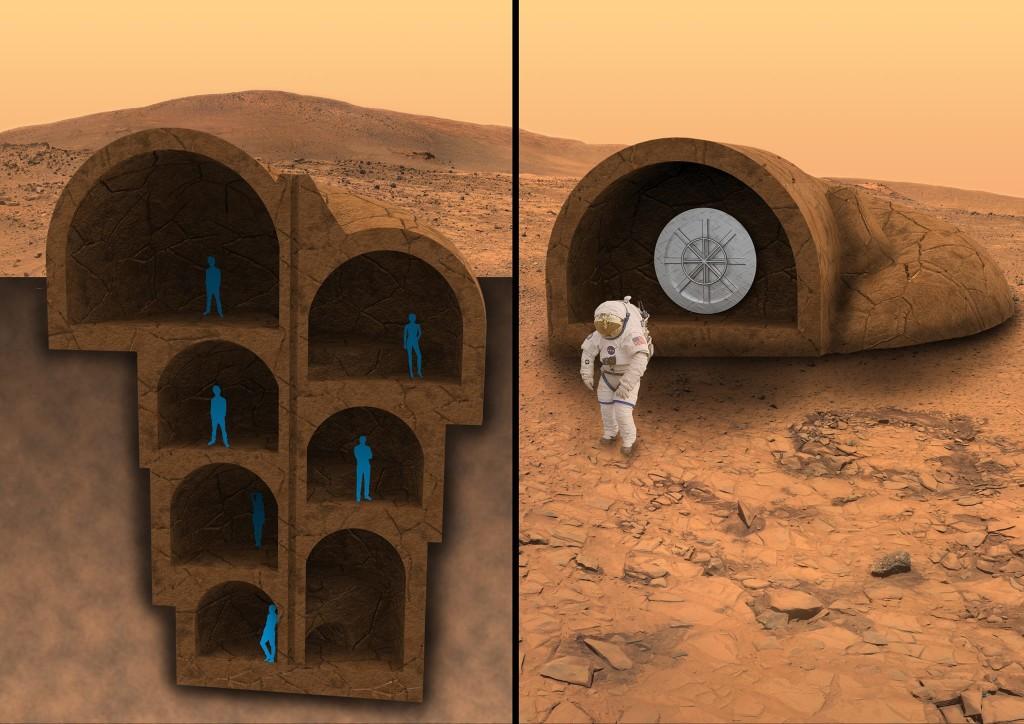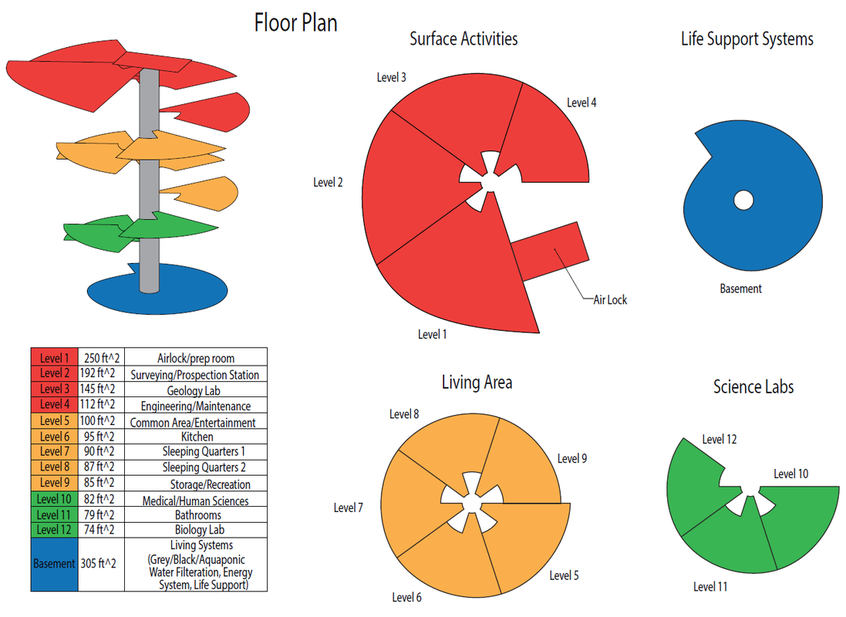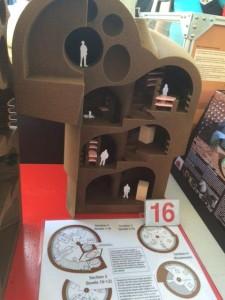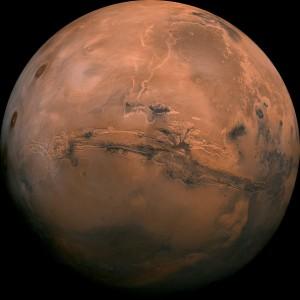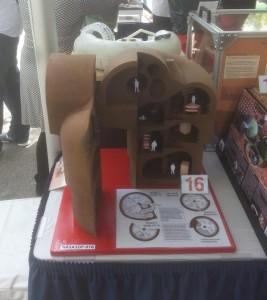 Last May when NASA launched their Mars 3D Printed Habitat Challenge teams of designers, artists, engineers, rocket scientists and 3D printing technology experts from all over the world tried their hands at creating what they hoped would be the first off-world settlement. From the hundreds of entries NASA scientists and engineers selected thirty finalists who were invited to present their habitat concepts at the 2015 New York Maker Faire where they selected the top three designs. While looking through the list of semi-finalists, one thing was clear: NASA had their work cut out for them if they were to pick a single winner. The creativity and engineering marvels that the teams created were equally exciting and ingenious and made it clear that it wasn’t so much would Mars be colonized, but when would Mars be colonized.
Last May when NASA launched their Mars 3D Printed Habitat Challenge teams of designers, artists, engineers, rocket scientists and 3D printing technology experts from all over the world tried their hands at creating what they hoped would be the first off-world settlement. From the hundreds of entries NASA scientists and engineers selected thirty finalists who were invited to present their habitat concepts at the 2015 New York Maker Faire where they selected the top three designs. While looking through the list of semi-finalists, one thing was clear: NASA had their work cut out for them if they were to pick a single winner. The creativity and engineering marvels that the teams created were equally exciting and ingenious and made it clear that it wasn’t so much would Mars be colonized, but when would Mars be colonized.
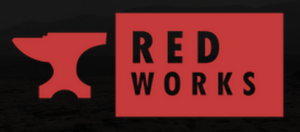 RedWorks was one of those thirty semi-finalists, and their Habitat design was inspired by the organic shapes of nautilus shells and the primitive pueblos used by early settlers. While RedWorks ultimately didn’t win the competition, the team did create a simple, and workable concept that they believe is still more than a viable option for off-planet colonization. The RedWorks team believes that their concept habitat design and the 3D printing process that they are developing to turn Martian regolith into 3D printing materials is part of a flexible manufacturing system that will create the shelter and tools necessary to survive on other planets. Most importantly they believe that their system will provide the lower costs needed to make settling on other planets achievable. And thanks to some recently passed laws and regulations, it is very likely that they are going to be given the chance to prove it sooner rather than later.
RedWorks was one of those thirty semi-finalists, and their Habitat design was inspired by the organic shapes of nautilus shells and the primitive pueblos used by early settlers. While RedWorks ultimately didn’t win the competition, the team did create a simple, and workable concept that they believe is still more than a viable option for off-planet colonization. The RedWorks team believes that their concept habitat design and the 3D printing process that they are developing to turn Martian regolith into 3D printing materials is part of a flexible manufacturing system that will create the shelter and tools necessary to survive on other planets. Most importantly they believe that their system will provide the lower costs needed to make settling on other planets achievable. And thanks to some recently passed laws and regulations, it is very likely that they are going to be given the chance to prove it sooner rather than later.
“November has been an eventful month for the spaceflight industry. The U.S. Commercial Space Launch Competitiveness Act, or the U.S. Space Act, was signed into law, legalizing mining for resources in space and reducing regulatory barriers for space startups. This creates the first legal framework for property rights in space, and makes it easier for new space companies to get started. The importance of this legislation is made even more relevant with Blue Origin’s successful launch and landing of the New Shepard rocket: the first reusable sub-orbital launch vehicle. The former establishes the legal infrastructure for private companies to operate in space, and the latter takes the first steps toward a dramatic drop in the cost of space travel. Together these actions lay the groundwork for a gold-rush in space,” explained RedWorks resident aerospace engineer Keegan Kirkpatrick in a recent blog post.
The blog post called The Space Boom lays out rather succinctly what challenges will need to be overcome before off-world colonies are possible, and at the same time Kirkpatrick explains how those challenges are rapidly become less and less of a concern. Because I never need an excuse to talk about space travel, and because these recent developments are essentially creating an entire new industry that will clearly be leveraging 3D printing technology, I wanted to find out more.
So I interviewed Kirkpatrick to learn his thoughts on where RedWorks fits into the future of commercial space colonization, and how he thinks that they’re going to get there.
Scott J Grunewald: The RedWorks Mars habitat was one of my favorite designs from NASA’s Mars habitat competition, mainly because it was one of the more simple, and obvious designs. It was almost like a Martian igloo, which is certainly a lot more feasible than many of the other entries and it is such an obvious way to use the local environment. It seems to me that when it comes to space travel and space colonization simple is almost always best, mainly because it reduces the amount of things that can go wrong. Was that a conscious effort on your part while working on your design?
Keegan Kirkpatrick: Absolutely, from the beginning we wanted to create a habitat that reflected proven habitat designs that humans have been using since the transition to agrarian societies from hunter-gatherers. The logic was that Early humans had access to basically the same materials you would have access to on Mars: Dirt, stone, water, and heat, and were able to grow fairly large communities using those simple ingredients (see ancient Sumeria, Babylon, and Egypt). If humans are to colonize Mars, then we cannot rely on building and launching a titanium soup can from Earth to Mars every two years, we have to make it possible for a colony to grow with what is available on the surface.
SJG: Can you tell me a little bit about how the idea for the habitat came together? Where did you draw inspiration, and how did the process evolve?
KK: It was a very organic process. I initially wanted something as basic as a Pit-House, which was employed by virtually every society that was just starting to transition to fixed living spaces, but most recognizably by the Pueblo peoples of the American Southwest. My teammate, and 3D printing guru Lino Stavole, came up with the idea of including a nautiloid spiral pattern in the habitat’s construction. Initially to provide better internal support, but it quickly became clear to me that a spiral exterior would be a great way to make use of any excavation sites as a kind of continuous spiral foundation. Basically you could distribute the load of the habitat over a larger area and give your 3D printing system a scaffolding to print off of after excavating your printing material. After that the design just kinda evolved with incremental changes, though the biggest change to the final design was the spiral staircase pattern for the habitat’s floorspace. Those pie shaped floors and spiral pattern maximized floor space and let us design each floor for a specific task. I like to think my dad might have influenced that decision, at least subconsciously, as he builds staircases for a living.
SJG: The habitat seems easily adaptable to other planetary surfaces, like a moon or an asteroid. Was the design intentionally versatile because you were looking beyond Mars?
KK: That wasn’t the plan from the start, but it became an obvious necessity of the design as we moved forward. Mars, the Moon, asteroids, are all frontiers, and any habitat setting up on their surfaces needs to adapt on the fly when facing a largely unexplored landscape. That’s where 3D printing, and to a larger extent algorithmic modeling is essential. Our habitat is set up to where with just a few initial conditions, the basic design can change shape to fit the needs of its buildsite. The most exciting aspect of this is coming across the opening to a cave, lava-tube, crevasse or caldera and essentially sealing the area off from the rest of Mars with the habitat. From there, the habitat can serve as a staging point to slowly terraform a closed off cavern into a new ecosystem, and thereby servicing a larger population of colonists.
SJG: So are you envisioning, at least at the start, that most larger off-planet settlements will be entirely subsurface? Have you considered any other types of structures necessary for large settlements, maybe for large gathering spaces, hydroponics and farming?
KK: Subsurface settlements that make use of existing caverns and lava-tubes will be considerably more practical for building large living spaces for colonies. On the Moon, it’s been estimated that some subsurface lava tubes could be as large as 5 km (~3 miles) in width, large enough for a fairly big city to develop. While that’s an extreme case, it’s clear that it is simply more efficient to use the subsurface features of a planet or moon in your favor to create a living space, rather than expend all the time and energy required to build large structures on the surface. We have considered the possibility of larger domed structures for creating contained biospheres for larger populations, but for now we’re keeping focused on smaller subsurface habitats that can make use of what’s already available in the topography of the planet. Its also worth mentioning that any structure we design for Mars has to already contain a self-sufficient aquaponic life support system that is capable of providing the air, food, and water needs of its occupants. An expanded subsurface domed habitat on the surface would still have to meet these needs, but at town/city scale an aquaponic system would begin to blur the lines with traditional farming and irrigation systems.
SJG: In your Space Boom blog post you lay out the reasons why space flight is about to get very interesting very quickly. How exactly do you plan to leverage that based on the work that you’ve already done with your Mars habitat?
KK: Let me put it this way, Planetary Resources and Deep Space industries are going to have A LOT of company in the space mining game once launch costs drop sufficiently. RedWorks wants to offer would-be prospectors the 3D printing system, the modern Covered Wagon, to build the basic infrastructure they’ll need to live and work on the Moon and Near Earth Asteroids. Our initial design is just the first step of what is needed for this, but the adaptability of the design makes it ideal for setting up shop on an asteroid or the moon.
SJG: What do you think that you will be bringing to the table that others will not?
KK: A diverse engineering culture. One thing we discovered at the New York Maker Faire was that a lot of these teams, even those with really great designs, were largely made up of people from the same background (architectural firms, industrial design schools, artists, etc.) While this is good for having your whole team always been on the same page, you risk creating an echo chamber, better known as a rigid engineering culture. RedWorks is made up of people working in graphic design, geology, sanitation, robotics, aerospace engineering, and commercial 3D printing. So we get a lot of diverse ideas coming together, and we don’t box ourselves into our own engineering culture. I can’t tell you how many times three or four of us are talking about three completely unrelated ideas for habitat or subsystem design, and they all just converge together into something wholly new, and better than what any individual was talking about.
SJG: How adaptable is your 3D printing technology to different environments? Will it be able to process and convert regolith into usable materials no matter what the surface being mined is made of? What are, if any, limitations that you foresee?
KK: It is important to note that almost all regolith we find on the Moon, Mars, and asteroids is mostly made of the same stuff, it’s just the trace materials that add any kind of variation. Most regolith is made primarily of silicates. Like dirt here on Earth (my geologist tells me it’s called Feldspar), the only difference is in space it’s devoid of water in a liquid state and is really, really fine (couple microns for each “grain”). So our process basically just heats those silicates to the point where you get something similar to a ceramic or gypsum concrete. The only compound that is significantly different is the basaltic regolith found near volcanic areas, and the only difference is the printer head would have to heat up the basalt quite a bit more to convert it to a molten material, and we have research data that says that’s very doable with a solar or microwave crucible.
SJG: What do you see as the biggest challenge to developing your technology into a functional off-world colonization system?
KK: From an engineering perspective: Mobility. 3D printers can make mistakes when they’re sitting on a counter, we need ours to be mobile and make a platform out of whatever surface is available to it. It’s tricky, but doable.
SJG: Can you tell me a little bit about some of the ideas being considered to accomplish this?
KK: I’m afraid I can’t be too specific at this stage, but to give you an idea on how something like this might be achievable, consider the software used on quadcopter drones to compensate for gusts of wind. That system may be the most iconic example of how attitude and stability control software is becoming more ubiquitous in our society; so it’s easy to imagine how such a system would enable a large mobile 3D printing system.
SJG: Can you give me a timeline for the development on your designs and technology based on what you have already done, what still needs to be done, and how long it should take to develop low cost space travel?
KK: Ha ha, I’d love to, but outside of the broad strokes you shouldn’t trust me, as I tend to get a little overexcited about the opportunities before us. I trust my team completely, but any engineer who tells you that he knows a project’s timeline just after the initial design process is lying to you. All I’ll say is that for 2016 we are going to start developing the first prototype In-situ-resource utilization (ISRU) printer and conducting some small scale tests of some of our major subsystems. We’re also gonna start developing some designs for some expanded settlements like I discussed earlier, exploring how a Martian or Lunar cave settlement with RedWorks habitats would actually function.
SJG: Would these prototypes and tests include full-scale on-Earth trials? Are there any Earth environments that would be suitable stand-ins for the surface of Mars?
KK: The one that we’re preparing to develop would be a small (desktop-scale) prototype, but it would eventually be developed into a full scale prototype for printing an Earth-analogue to our Mars Habitat. Being close to the Mojave and Death Valley we’re actually ideally situated to conduct Earth-analog tests of some of the more common environments on Mars, specifically the equatorial regions of the Martian Northern Hemisphere. The local materials in the soil are fairly similar in composition and structure to those on Mars, which would be suitable for testing the ISRU 3D printing and excavation systems we’ll need on Mars. The dry climate and relatively equal day-night cycle would also let us replicate how power and water systems would behave on Mars.
SJG: Are there any plans to adapt the habitat design for use here on Earth? There are certainly areas of the planet that are warming up, and it is easy to see future housing solutions building down rather than building up.
KK: That has always been part of our goals for the project. Construction on Earth has some obvious advantages to Mars, perhaps none more significant that the fact that a 3D printer could use processed materials (concrete, steel, copper, etc) to build a structure better suited to the limitations imposed by the Earth. Higher gravity and an active tectonic system means we don’t have the luxury of a plethora of large inactive lava-tubes just beneath the surface. So our printer would be better suited as an alternative to traditional construction techniques already in use, reducing costs, and time by relying on more compact, semi-autonomous construction systems.
Not only will the advanced 3D printing technologies currently being developed by RedWorks and companies like them pave the road to humans living in space, but they will also be paving new roads here on Earth. New roads that will lead us to living cleaner and smarter than ever before. You can learn more about the RedWorks Habitat on their website, and make sure that you check out their blog and read the Space Boom article that inspired my conversation with Keegan.
Subscribe to Our Email Newsletter
Stay up-to-date on all the latest news from the 3D printing industry and receive information and offers from third party vendors.
You May Also Like
3D Printing Unpeeled: New Arkema Material for HP, Saddle and Macro MEMS
A new Arkema material for MJF is said to reduce costs per part by up to 25% and have an 85% reusability ratio. HP 3D HR PA 12 S has been...
3D Printing News Briefs, January 20, 2024: FDM, LPBF, Underwater 3D Printer, Racing, & More
We’re starting off with a process certification in today’s 3D Printing News Briefs, and then moving on to research about solute trapping, laser powder bed fusion, and then moving on...
3D Printing Webinar and Event Roundup: December 3, 2023
We’ve got plenty of events and webinars coming up for you this week! Quickparts is having a Manufacturing Roadshow, America Makes is holding a Member Town Hall, Stratafest makes two...
Formnext 2023 Day Three: Slam Dunk
I’m high—high on trade show. I’ve met numerous new faces and reconnected with old friends, creating an absolutely wonderful atmosphere. The excitement is palpable over several emerging developments. The high...


